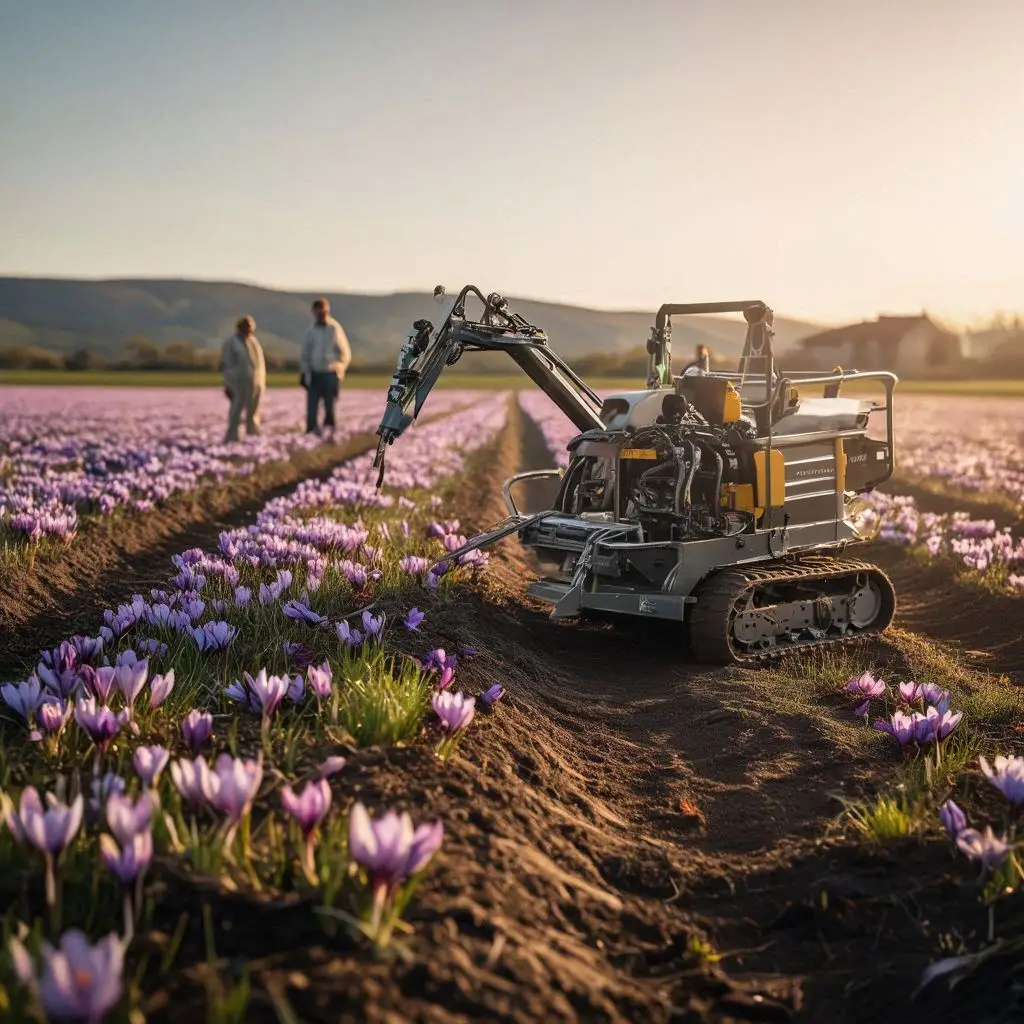
Saffron Harvesting: Crocus Automated Machine for Sale
Saffron, often labeled as “red gold,” is one of the world’s most expensive and prized spices due to its high market value and the labor-intensive harvesting process involved. This article delves into saffron harvesting techniques, the role of Crocus plants, advancements in automated technology, and where to find harvesting machines for sale.
Introduction
Introduction: The Rising Interest in Saffron Harvesting
Saffron harvesting is gaining global traction due to rising culinary, medicinal, and cosmetic uses. Extracted from the Crocus sativus flower, saffron is handpicked with precision and care—a tradition rooted in centuries of agricultural heritage. However, with modern advancements and the increasing demand for efficiency, automated saffron harvesting machines are reshaping how farmers approach this delicate crop.
Saffron Harvesting
Saffron Harvesting: A Labor-Intensive Yet Rewarding Practice
Saffron harvesting involves collecting the vivid red stigmas from the Crocus sativus flower. These stigmas are dried and processed to produce the highly sought-after spice. Each Crocus sativus flower yields only three delicate stigmas, meaning thousands of flowers are needed to produce just one pound of saffron. The harvesting process is traditionally done by hand in the early morning to ensure maximum freshness and potency. Saffron is generally harvested during the autumn season, with regional climate variations influencing the exact timing. The world’s top saffron-producing countries include Iran, India (particularly Kashmir), and Spain, which offer the ideal environmental conditions for Crocus sativus cultivation and large-scale saffron harvesting.
Due to the time-sensitive nature of the bloom—often lasting just one or two days—laborers must work swiftly, picking flowers at their peak. Post-harvest, the stigmas undergo careful drying to maintain their chemical composition, including safranal, crocin, and picrocrocin—key compounds responsible for saffron’s flavor, color, and aroma.
Crocus Saffron Harvesting
Crocus Saffron Harvesting: Understanding the Role of Crocus Sativus
At the core of saffron cultivation is the Crocus sativus flower, the only known source of this valuable spice. Crocus saffron harvesting focuses on nurturing these delicate plants through a precise cultivation cycle. Grown from corms, not seeds, the flowers require well-drained, rich soil and a specific climate—dry summers and cool-to-cold winters.
Proper planting, spacing, irrigation, and pest control are critical for healthy Crocus fields. When flowering begins, each bloom must be picked by hand before sunrise to avoid wilting and ensure the saffron retains its maximum potency. Farmers must handle each flower delicately to extract the stigmas without damaging them. The careful processing that follows—drying, grading, and storing—affects both the yield and quality of the final product.
Given its labor intensity, crocus saffron harvesting is a costly endeavor. However, innovations like crop scheduling and mechanized assistance are being introduced to streamline the process, especially in regions looking to scale production for export.
Automated Saffron Harvesting
Automated Saffron Harvesting: Innovation Meets Tradition
Automated saffron harvesting is emerging as a groundbreaking solution to reduce labor costs and increase productivity. With the growing global demand and the increasing scarcity of skilled labor, the agriculture sector is investing in robotic and AI-powered harvesting technologies tailored to Crocus flowers.
Automated systems use image recognition, motion sensors, and soft gripping tools to identify, pluck, and collect stigmas with precision. Unlike traditional harvesting, which can take days, automated saffron harvesting machines can cover fields much faster with minimal human intervention. These machines are often designed to be lightweight, mobile, and efficient for small-scale or experimental farms.
While the technology is still evolving, pilot programs in Spain, Italy, and parts of Iran have shown promising results. However, high initial costs, limited scalability, and the fragility of Crocus blooms mean that full automation is still not widespread. Nonetheless, the integration of partial automation (e.g., mechanical plucking combined with manual stigma separation) is gaining popularity among forward-thinking saffron growers.
Saffron Harvesting Machine for Sale
Saffron Harvesting Machine for Sale: Where to Buy and What to Consider
Farmers looking to modernize their saffron cultivation can now explore various saffron harvesting machines for sale. These machines range from semi-automated harvesters to fully robotic systems designed for precision agriculture. When selecting a saffron harvesting machine, key factors to consider include field size, automation level, build quality, origin, pricing, and long-term return on investment (ROI), all of which significantly impact harvesting efficiency and overall profitability.
Crop Size & Field Layout: Smaller fields may benefit from handheld or semi-automated tools, while larger farms may need more advanced robotic systems.
- Sensitivity Controls: Ensure the machine can delicately handle Crocus blooms without damaging the stigmas.
- The price range for saffron harvesting machines typically falls between $5,000 and $50,000, depending on the level of automation, country of manufacture, and advanced features. These factors directly impact both the initial investment and the potential return on investment (ROI) for saffron farmers.
- After-Sales Support: Choose a manufacturer offering training, maintenance, and tech support.
You can find saffron harvesting machines for sale through specialized agricultural equipment providers, European agri-tech developers, or platforms like Alibaba, Made-in-China, and Amazon Business. Keep an eye on brands working with local universities or agricultural institutes, as these may offer custom-built or subsidized options for research-based saffron projects.
Future Of Saffron Harvesting Technology
Future Of Saffron Harvesting Technology: Toward Smart, Scalable Farming
Saffron harvesting, a time-honored and labor-intensive tradition, is now embracing a technological renaissance through automated machinery, precision tools, and modern agricultural innovations aimed at increasing yield and efficiency. Precision agriculture will likely play a critical role in optimizing planting cycles, predicting bloom times, and managing resources such as water and nutrients more effectively. Drones, soil sensors, and mobile apps could complement automated harvesters to create a fully connected saffron farm.
Startups and agri-tech firms are already experimenting with machine learning models that help predict flower maturity, detect pest issues, and reduce human error. With the right investment and adoption, these technologies could revolutionize saffron cultivation in both traditional regions and new territories like the United States, Australia, and China.
Sustainability is also a driving force. Automated systems reduce waste, water usage, and chemical dependency, making saffron farming more eco-friendly and economically viable. As innovation continues, expect more compact, affordable machines suitable for smallholder farmers, opening up opportunities for local saffron production worldwide.
Conclusion
Conclusion: Bridging Heritage and Innovation in Saffron Harvesting
Saffron harvesting, a centuries-old agricultural tradition, is now undergoing a technological transformation with the introduction of automated machines, smart tools, and modern farming innovations that boost efficiency and quality. From handpicking Crocus sativus blooms to deploying automated machines for large-scale operations, the saffron industry is evolving. Crocus saffron harvesting remains at the core, but automation is rapidly expanding the possibilities for producers worldwide.
With automated saffron harvesting machines for sale, farmers can increase efficiency and reduce costs while preserving the spice’s authenticity and quality. As technology becomes more accessible, the future of saffron farming looks both sustainable and scalable—offering new opportunities to those ready to embrace innovation.

